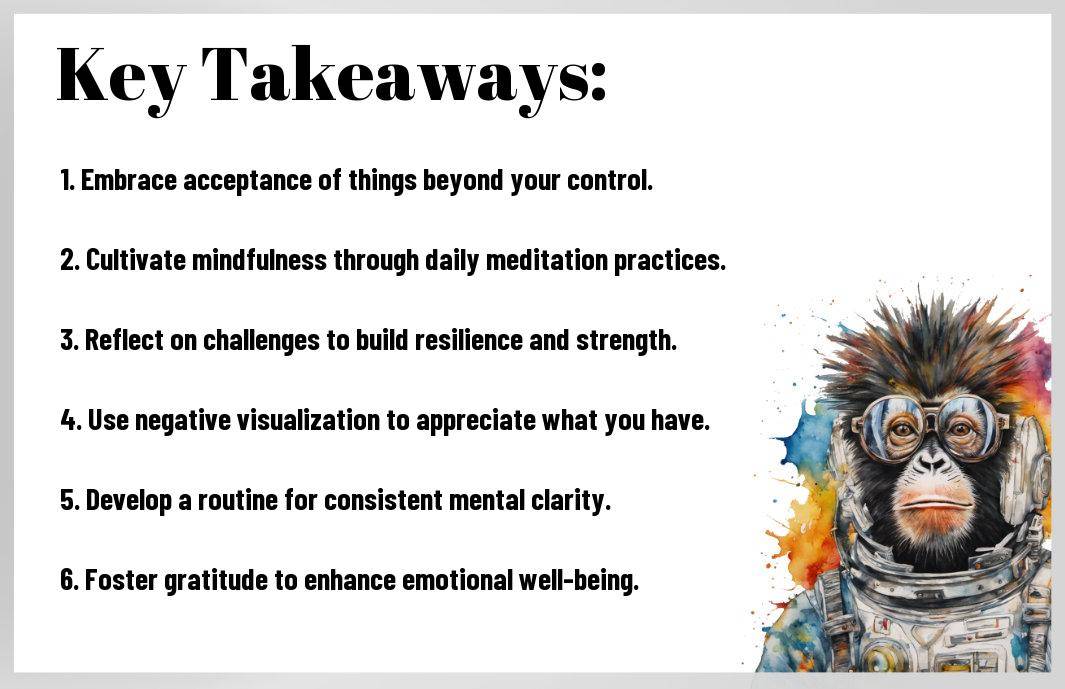Over the years, I’ve discovered the profound benefits of combining meditation with Stoic philosophy to cultivate inner strength. Stoicism teaches us to embrace challenges and build resilience, while meditation provides a space for reflection and mindfulness. In this post, I’ll share some practical techniques that can help you integrate these two powerful practices into your daily routine. By doing so, you can strengthen your mental fortitude and navigate life’s ups and downs with greater ease and confidence.
Key Takeaways:
- Emotional Resilience: Stoic meditation fosters a strong sense of emotional endurance, helping to tackle life’s challenges effectively.
- Mindfulness Practice: Regular meditation enhances focus and awareness, promoting a mindful approach to daily experiences.
- Contemplation of Mortality: Reflecting on mortality encourages appreciation for life and motivates action towards meaningful goals.
- Acceptance: Embracing what cannot be changed reduces anxiety and cultivates inner peace.
- Virtue Development: Meditation encourages the nurturing of virtues such as wisdom, courage, and justice, which strengthen character.
- Self-Reflection: Stoic meditation includes analyzing one’s thoughts and actions for personal growth and improvement.
- Community Connection: Understanding the interconnectedness of humanity fosters empathy and strengthens relationships.

Understanding Stoicism
A lot of people today are looking for ways to cultivate resilience and inner peace, and that’s where Stoicism comes in. This ancient Greek philosophy teaches us how to manage our emotions, focus on what we can control, and accept what we cannot. As I investigate its principles, I find that Stoicism offers not just a way to cope with life’s challenges but also a roadmap to living a fulfilled life. Central to this philosophy is the idea that our perception shapes our reality, urging us to shift our mindset to achieve greater strength and harmony in our day-to-day experiences.
The Basics of Stoic Philosophy
Along with understanding the historical backdrop of Stoicism, it’s important to embrace its core tenets. At the heart of Stoic philosophy, you will find the teachings around virtue, reason, and the distinction between what is up to us and what is not. I love how Stoics emphasize that practicing virtue, such as wisdom, courage, and justice, leads to true happiness, rather than fleeting pleasures. Moreover, by recognizing the limits of our control, I find it easier to let go of frustrations that arise from external circumstances, fostering a sense of calmness that is incredibly liberating.
Key Stoic Thinkers
Any discussion of Stoicism wouldn’t be complete without mentioning its key thinkers, who have shaped the philosophy over the centuries. Figures like Seneca, Epictetus, and Marcus Aurelius offer invaluable insights that resonate even in modern life. I enjoy exploring their writings and often find myself reflecting on their perspectives. Each thinker brought a unique angle to Stoicism, enriching its depth and making it accessible to people from all walks of life.
Even though these thinkers lived in different times and contexts, their teachings carry timeless wisdom that speaks to me today. Seneca’s letters offer practical advice for navigating the trials of life, while Epictetus’s emphasis on personal responsibility is a powerful reminder that I hold the key to my reactions and mindset. Marcus Aurelius, as a Roman Emperor, showcases that Stoicism isn’t just for philosophers; it’s a practical philosophy for anyone seeking to cultivate inner strength and resilience amidst life’s complexities.

The Benefits of Meditation
Even a few minutes of meditation each day can bring about significant positive changes in our lives. By integrating this practice into my routine, I’ve found that I not only cultivate inner strength but also enhance my overall well-being. Meditation serves as a retreat from the chaos of daily life, allowing me to connect with my thoughts and emotions more deeply. This connection fosters a greater awareness of my surroundings and improves my ability to handle stress and challenges with grace.
Mindfulness and Presence
Along my meditation journey, I’ve discovered that mindfulness is one of the key benefits I can harness. By training my mind to focus on the present moment, I begin to appreciate the beauty in my daily experiences, instead of getting lost in worries about the past or future. Whether it’s enjoying a warm cup of tea or taking a walk in nature, these moments become richer and more vibrant when I practice being fully present. This not only enhances my mood but also nurtures my relationships, as I become more attentive to those around me.
Building Emotional Resilience
To build emotional resilience through meditation, I’ve found that developing a strong mental foundation helps me navigate life’s ups and downs with greater ease. Each time I sit in quiet reflection, I’m reinforcing my ability to cope with adversity. This practice allows me to observe my emotions without letting them overwhelm me, creating a buffer against life’s inevitable stresses. Additionally, I can return to a state of calmness more easily when challenges arise, empowering me to respond rather than react impulsively.
Building emotional resilience isn’t just about enduring the tough times; it’s also about thriving during them. By acknowledging my feelings during meditation, I’ve learned to view setbacks as opportunities for growth rather than obstacles. Embracing this mindset allows me to bounce back stronger and more centered, equipped to face future challenges head-on. Each small victory in meditation builds a reserve of strength that transforms how I approach life’s unpredictability.

Meditative Practices Inspired by Stoicism
Many times, I find myself searching for ways to cultivate inner strength, and the meditative practices of Stoicism provide valuable insights. By integrating techniques such as daily reflection and negative visualization into my routine, I feel more equipped to handle life’s challenges with greater composure and resilience. Stoicism teaches us to focus on what we can control and to accept what we cannot, and through meditation, these teachings become more profound in my daily life.
Daily Reflection
Before plunging into the art of daily reflection, I often take a moment to center myself and prepare for introspection. This practice involves carving out a specific time each day to contemplate my thoughts, feelings, and actions. I may ask myself questions like, “What did I do well today?” or “What could I have improved upon?” By doing so, I cultivate a deeper sense of self-awareness and understanding. This time to reflect allows me to celebrate my successes, no matter how small, while also acknowledging areas for growth.
Negative Visualization
Visualization plays a pivotal role in my meditative practices, particularly in the technique of negative visualization. In this exercise, I intentionally envision the loss of something I hold dear—be it a personal possession, a relationship, or even my own health. This practice isn’t about dwelling in sadness; rather, it empowers me to appreciate what I have in the present moment and fosters resilience within me. By contemplating potential hardships, I find myself more prepared to face challenges, creating a sense of mental fortitude that enhances my day-to-day life.
Reflection on negative visualization reminds me that impermanence is a natural part of existence. When I engage in this practice, I learn to cherish my experiences and relationships. It acts as a gentle reminder that nothing is guaranteed, encouraging me to live fully in the moment. By imagining the ‘what-ifs,’ I reinforce my capacity to navigate difficulties with grace and composure. Through these techniques, I continue to build my inner strength, embracing life’s uncertainties with a Stoic heart.
Integrating Stoic Principles into Meditation
Now that we’ve established the foundations of Stoic meditation, let’s investigate into how we can weave these timeless principles into our daily practice. One of the keys to enhancing your meditation experience lies in the concept of detachment from outcomes. When I sit in silence, I often find myself letting go of any expectations about how the session should go. Instead of fixating on achieving a specific state of mind, I focus on the process itself, allowing the ebb and flow of thoughts and feelings to pass through me without judgement. This approach arms me with the inner strength I need to face life’s unpredictability.
Detachment from Outcome
Behind every meditation session lies an opportunity for exploration and growth. By practicing detachment from outcome, I allow my mind to explore without the pressure of perfection. I find that this mental liberation not only enhances my ability to concentrate but also instills a profound sense of peace within me. By dismissing the need for a specific result, I invite an authentic experience every time I sit down to meditate, nurturing a state of openness that is both refreshing and empowering.
Acceptance and Control
From my experience, establishing a clear boundary between what I can control and what I cannot has been transformative. During meditation, I focus on the things within my power: my breath, my thoughts, and my emotional responses. By acknowledging those areas where I have influence, I can let go of the external pressures and stressors that lie outside my control. This realization allows me to cultivate a greater sense of acceptance, as I remind myself that life will unfold as it should, regardless of my desires or ambitions.
And as I continue to embrace acceptance, I notice a shift in my overall outlook. The weight of expectations starts to lift, leading to a more relaxed and forgiving approach towards both myself and others. This practice not only enriches my meditation sessions but also spills into other aspects of my life, guiding my interactions and decisions. Through acceptance and the understanding of control, I find that I can navigate life’s challenges with grace and resilience.
Meditate Like a Stoic for Inner Strength
Unlike the hurried pace of our daily lives, creating your own meditation routine allows you to pause, reflect, and cultivate inner strength. The key to integrating Stoic principles into your meditation practice lies in establishing a consistent and meaningful routine that works for you. Start by determining how often and when you’d like to meditate. Whether it’s ten minutes in the morning or a half hour in the evening, consistency makes all the difference. You might even consider choosing specific themes or Stoic teachings to contemplate during your sessions to deepen your understanding and application of these philosophies.
Setting the Right Environment
Among the many factors that contribute to a successful meditation routine, setting the right environment plays a significant role. I find that creating a serene atmosphere allows me to connect more deeply with my thoughts and feelings. To achieve this, consider decluttering your space, dimming the lights, and perhaps lighting a candle or using necessary oils that promote relaxation. Each element should reflect personal comfort, ensuring you feel safe and at ease while engaging with your inner self.
Finding Your Quiet Space
Before jumping into your meditation practice, it’s important to find a quiet space where you can enjoy uninterrupted moments of introspection. I often explore different areas in my home—whether it’s a cozy corner in my living room or a peaceful nook in my bedroom—that feels inviting for mindfulness. Choosing a location that has minimal distractions not only helps in maintaining focus but also enhances the overall experience of meditative practice.
Creating a designated quiet space can be as simple as selecting a favorite spot or even using a chair by a window. I like to personalize my space with a few meaningful items, like a comfortable blanket or my favorite book of Stoic quotes, to inspire my meditation sessions. Ultimately, the goal is to make this space feel like your own sanctuary, a place that draws you in and fosters tranquility, making it easier for you to cultivate inner strength through your meditation practice.
Challenges and Overcoming Obstacles
All of us encounter challenges when we try to establish a meditation practice that echoes the stoic approach to life. Daily distractions, busy schedules, and even our own internal dialogues can make it hard to sit in silence and connect with our inner selves. I often find that the mind wanders easily, and it can be frustrating to experience that tug of war between my intentions and reality. The beauty of a stoic mindset, however, is the understanding that obstacles are part of the process and an opportunity for growth. By facing these challenges head-on, I am actively building my resilience and inner strength—truly embodying what it means to meditate like a stoic.
Common Hindrances in Meditation
To navigate the waters of meditation successfully, it’s helpful to identify some common hindrances that I’ve encountered along the way. One prevalent obstacle for me has been the incessant chatter of my thoughts. I often find that my mind is a bustling marketplace filled with unfinished tasks and unexpected worries. Additionally, physical discomfort can distract me, making it difficult to focus on my breath or the present moment. It’s normal to face these hurdles, and acknowledging them is the first step toward overcoming them in a stoic manner.
Staying Committed to Your Practice
Common pitfalls in maintaining a meditation practice can lead to frustration or disillusionment. I personally have found that life can easily pull me away from my routines, causing me to skip sessions and slowly drift away from the practice. Setting a consistent schedule and finding a comfortable spot in my home serves as part of the solution, but mental commitment is just as important. I often have to remind myself why I began meditating in the first place—this self-reflection helps me stay accountable to my practice and prevent slipping away from it.
Practice makes perfect, but I’ve also learned that a flexible attitude goes hand in hand with commitment. If I miss a session, I try not to beat myself up over it; instead, I remind myself that it’s a marathon, not a sprint. Gradually, I’ve started to embrace the idea of just showing up, even if it’s for a few minutes. By allowing myself grace and understanding, I find that staying engaged with meditation becomes a more fulfilling journey, aligning with the stoic principle of accepting what I cannot control and focusing on my response to challenges.
Summing Up
Presently, I find that practicing Stoic meditation significantly enhances my inner strength. By embracing the principles of Stoicism while focusing on my mind and emotions, I cultivate resilience and clarity. Each time I meditate, I feel like I’m building my own inner citadel, a sanctuary where I can retreat from life’s stresses. If you’re interested, I discovered valuable insights in an article that I found enlightening. You might enjoy reading about Meditating my way to the inner citadel and how it parallels my own experiences.
Additionally, weaving Stoic philosophies into my meditation practices helps me refocus on what truly matters while letting go of the noise that life often presents. I invite you to explore this approach for yourself, as it can lead to a profound sense of peace and emotional stability. Together, we can navigate the complexities of life with newfound wisdom, turning to our inner resources whenever we face challenges. So let’s embrace Stoic meditation and unlock our potential for a stronger, more resilient self.
FAQ
Q: What is “Meditate Like a Stoic”?
A: “Meditate Like a Stoic” is a practice that combines ancient Stoic philosophy with modern meditation techniques. This approach focuses on developing mental resilience and inner strength through mindfulness, reflection, and the application of Stoic principles, such as acceptance, virtue, and rationality.
Q: How can I start meditating like a Stoic?
A: To begin meditating like a Stoic, set aside a few quiet moments daily. Start with deep breathing to center yourself. Next, reflect on Stoic teachings, focusing on concepts like the dichotomy of control—noting what you can change and what you cannot. You can also journal your thoughts to deepen this reflection.
Q: What are the benefits of meditating like a Stoic?
A: Meditating like a Stoic can enhance emotional resilience, reduce anxiety, and promote a clearer perspective on challenges. It encourages mindfulness and helps practitioners develop a greater sense of inner strength, allowing for more thoughtful responses to life’s difficulties.
Q: How often should I practice Stoic meditation?
A: Consistency is key. Aim to practice Stoic meditation daily, even if only for a few minutes. As you get comfortable, you can extend the duration or frequency. The aim is to make it a habitual part of your daily routine, which can help solidify its benefits over time.
Q: Are there specific Stoic texts I should read to enhance my meditation practice?
A: Yes, reading important Stoic texts can deepen your understanding and practice. Key works include “Meditations” by Marcus Aurelius, “Letters from a Stoic” by Seneca, and “Discourses” by Epictetus. These texts provide insights into Stoic philosophy that can greatly inform your meditation sessions.
Q: Can I meditate like a Stoic if I am new to meditation?
A: Absolutely! Stoic meditation is accessible for beginners. Start with basic mindfulness and reflection, focusing on Stoic principles at your own pace. As your comfort with meditation grows, you can expand your practice to incorporate more advanced elements. Each step taken is valuable.
Q: How can I apply the lessons from Stoic meditation in my daily life?
A: Applying lessons from Stoic meditation to daily life involves integrating Stoic principles into your actions and thoughts. Practice acceptance of outcomes beyond your control, cultivate a mindset of gratitude, and focus on virtuous behavior. Use your meditation insights to guide your responses to everyday challenges, reinforcing the lessons learned through practice.


